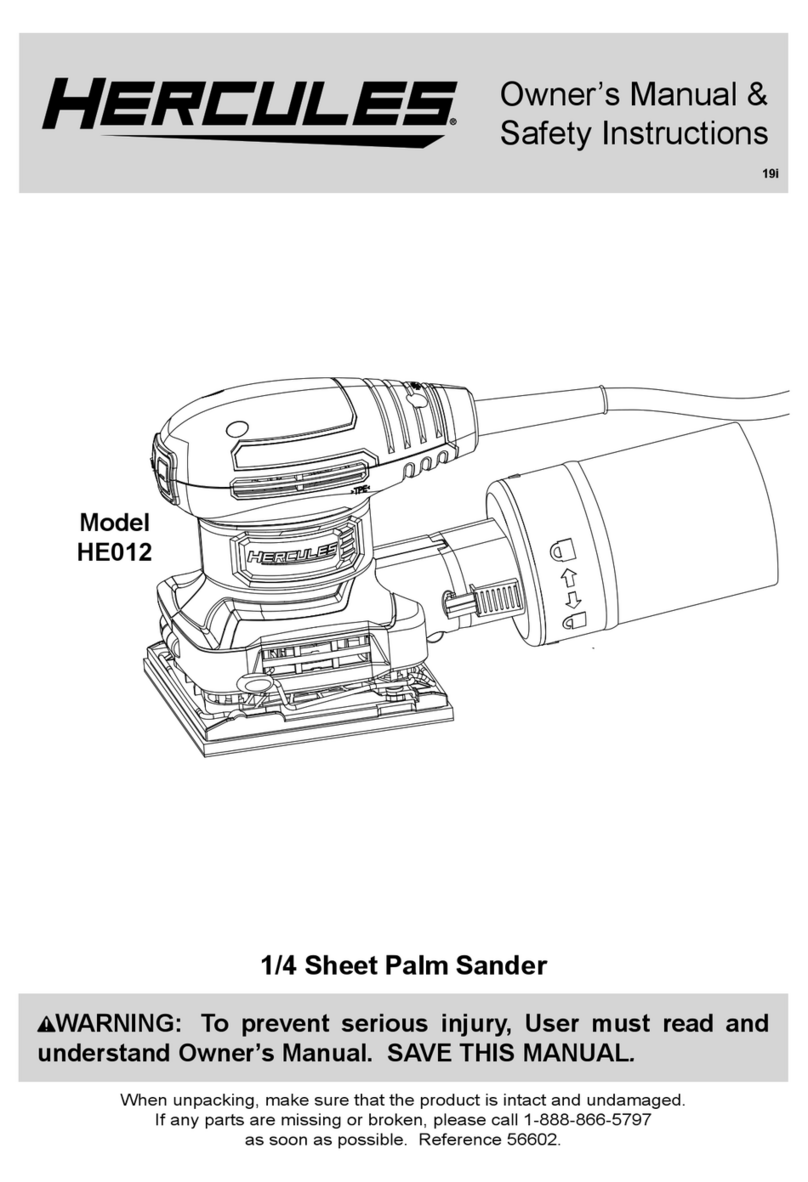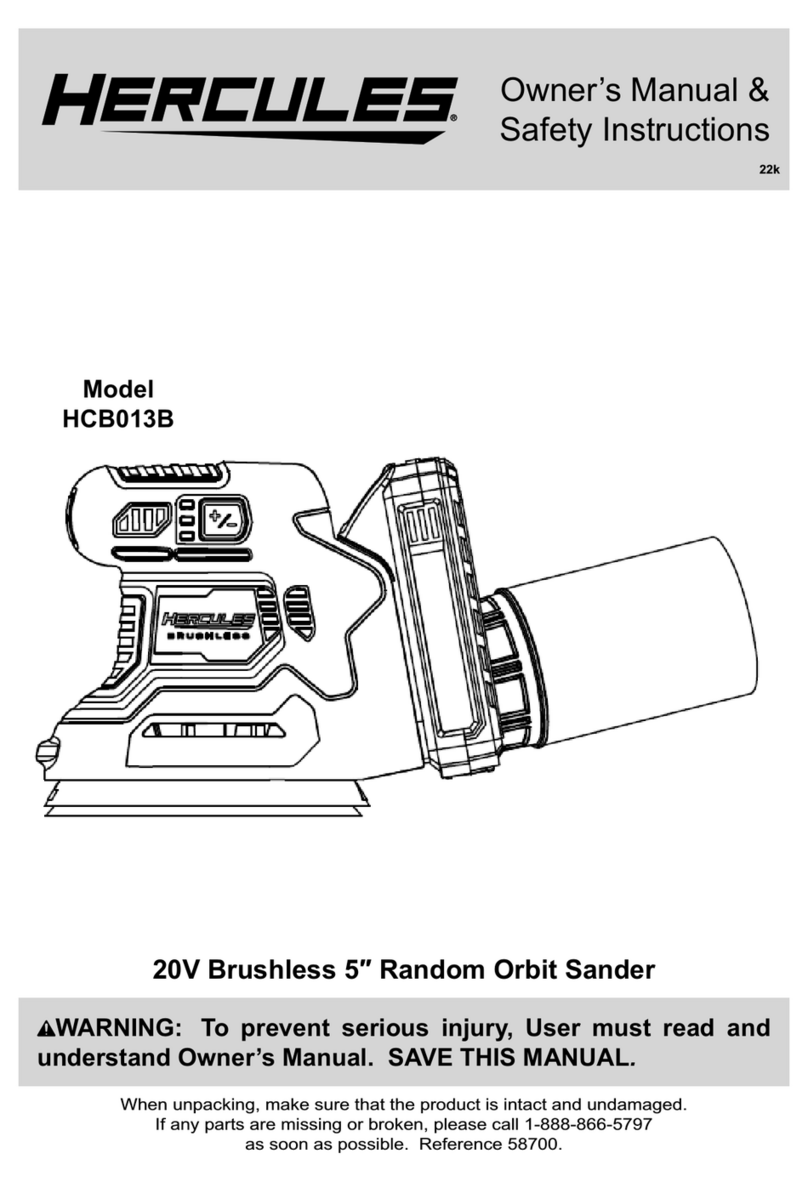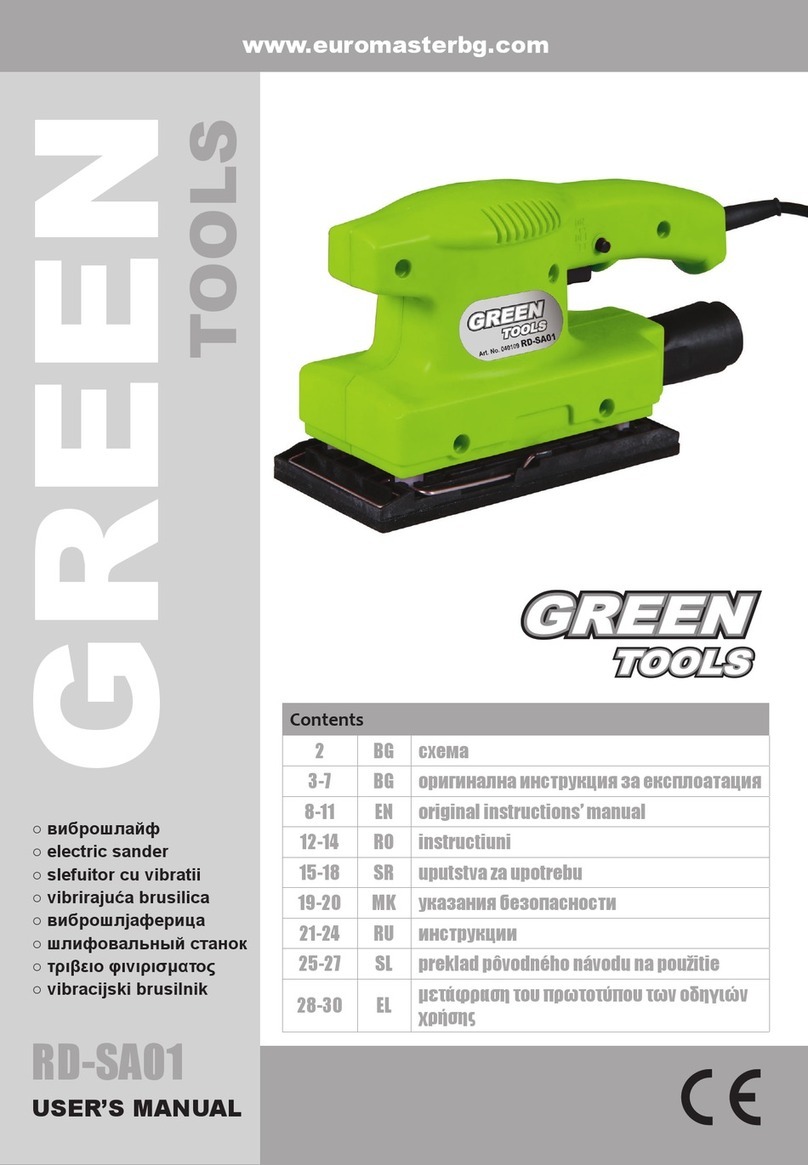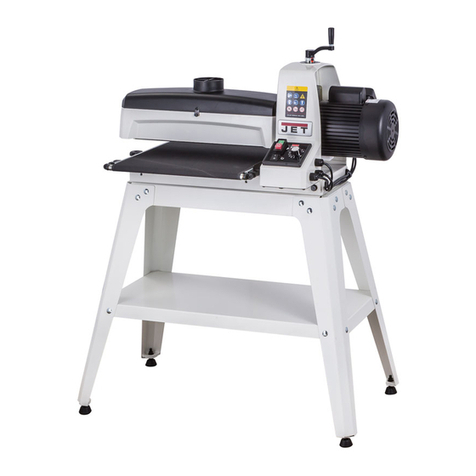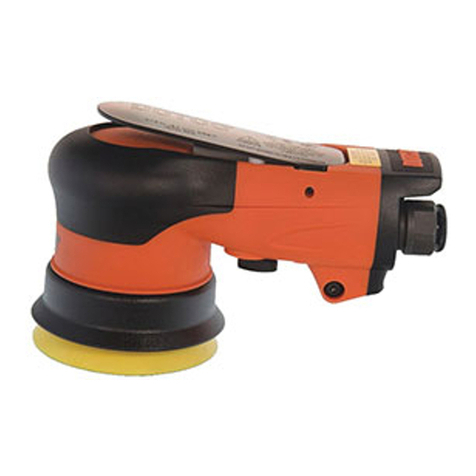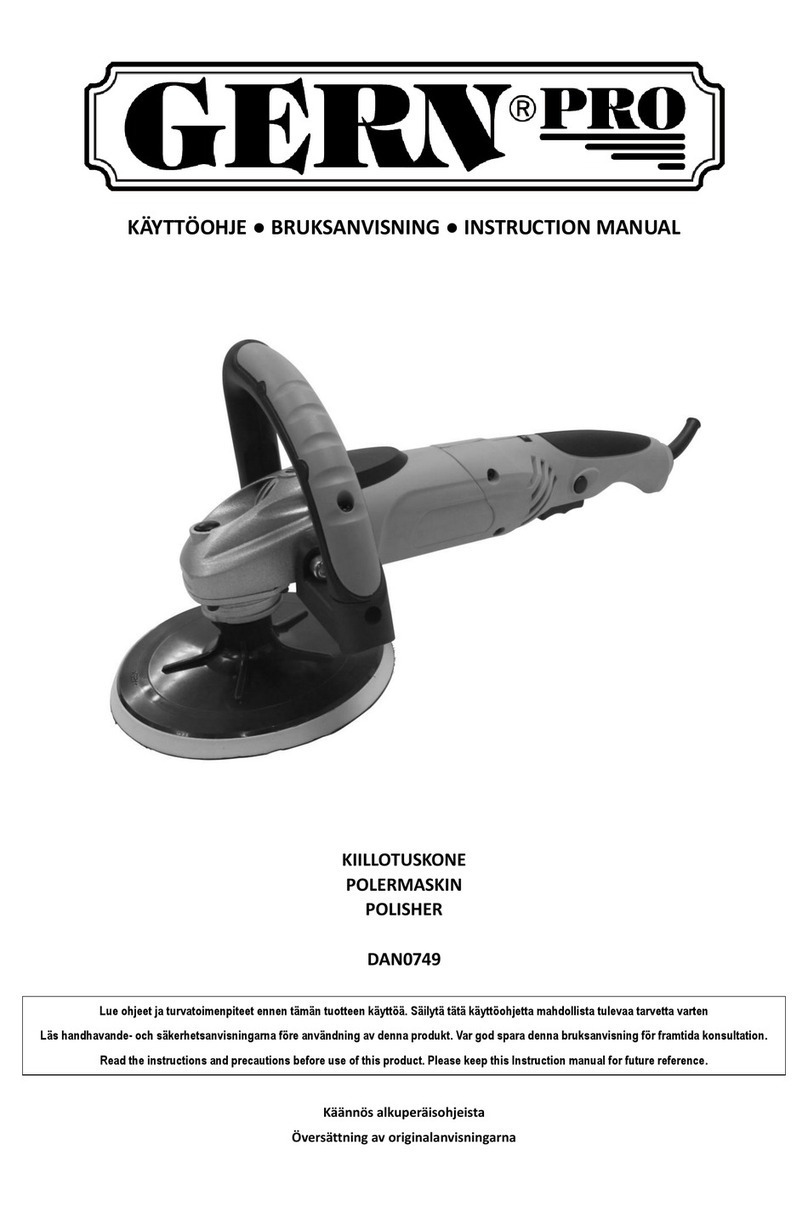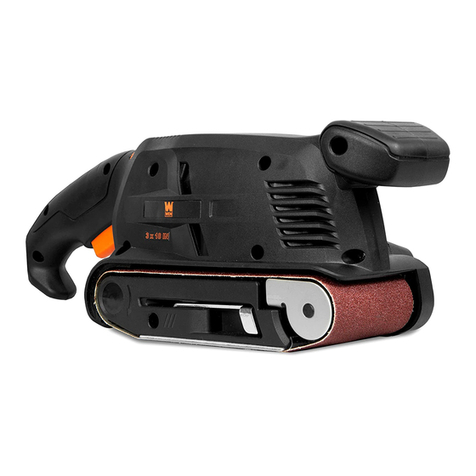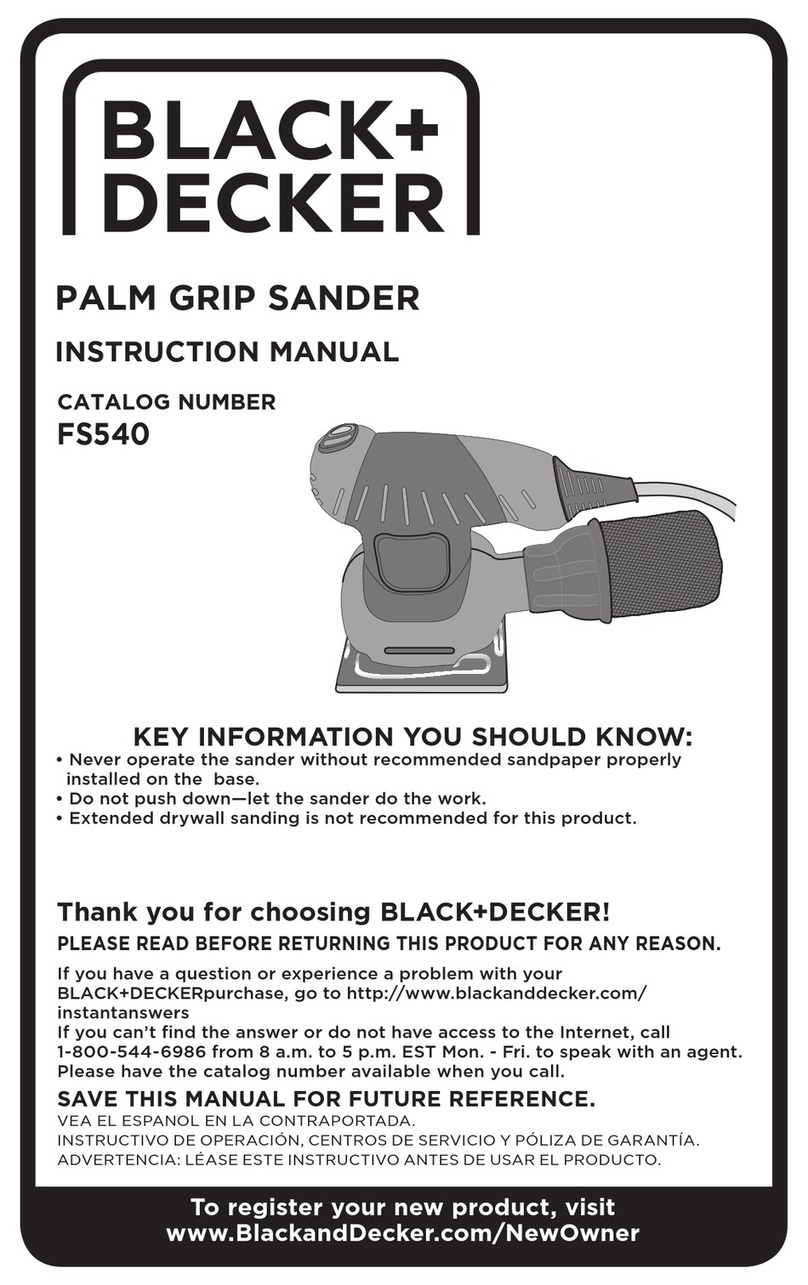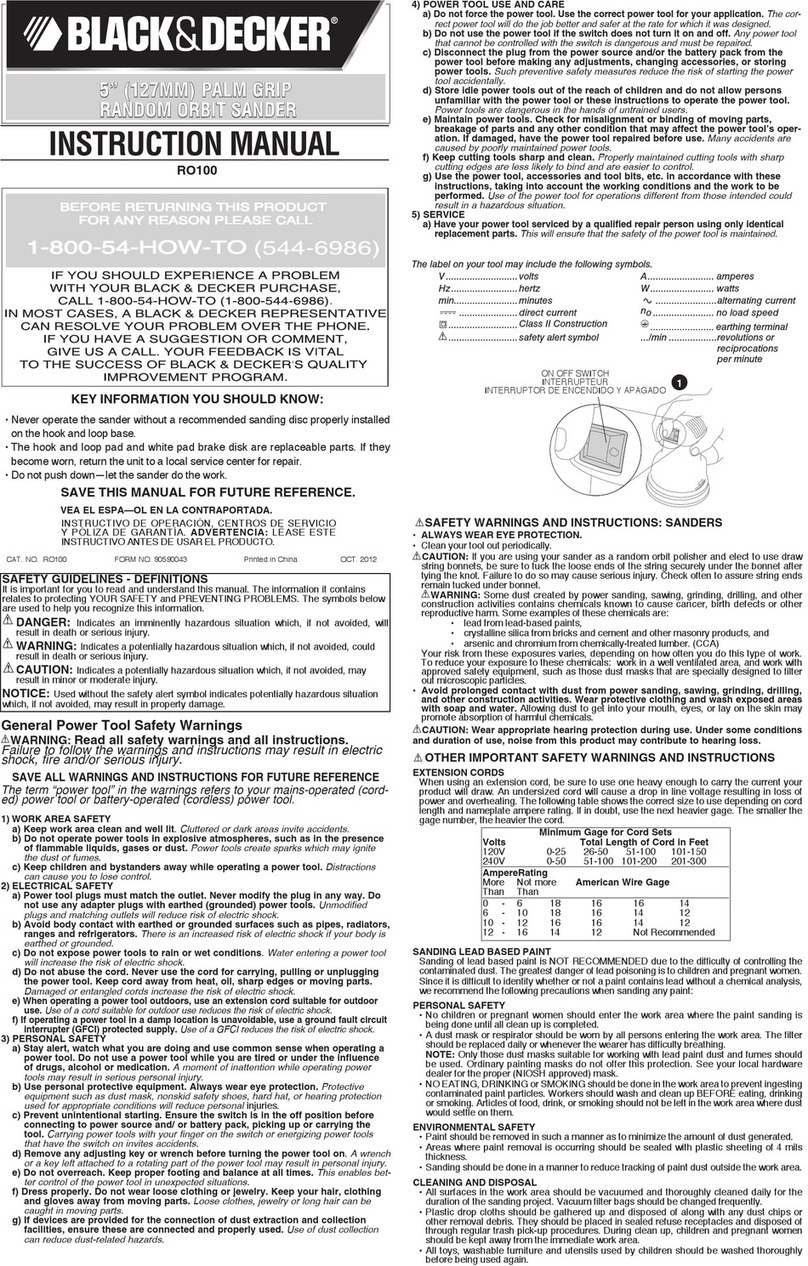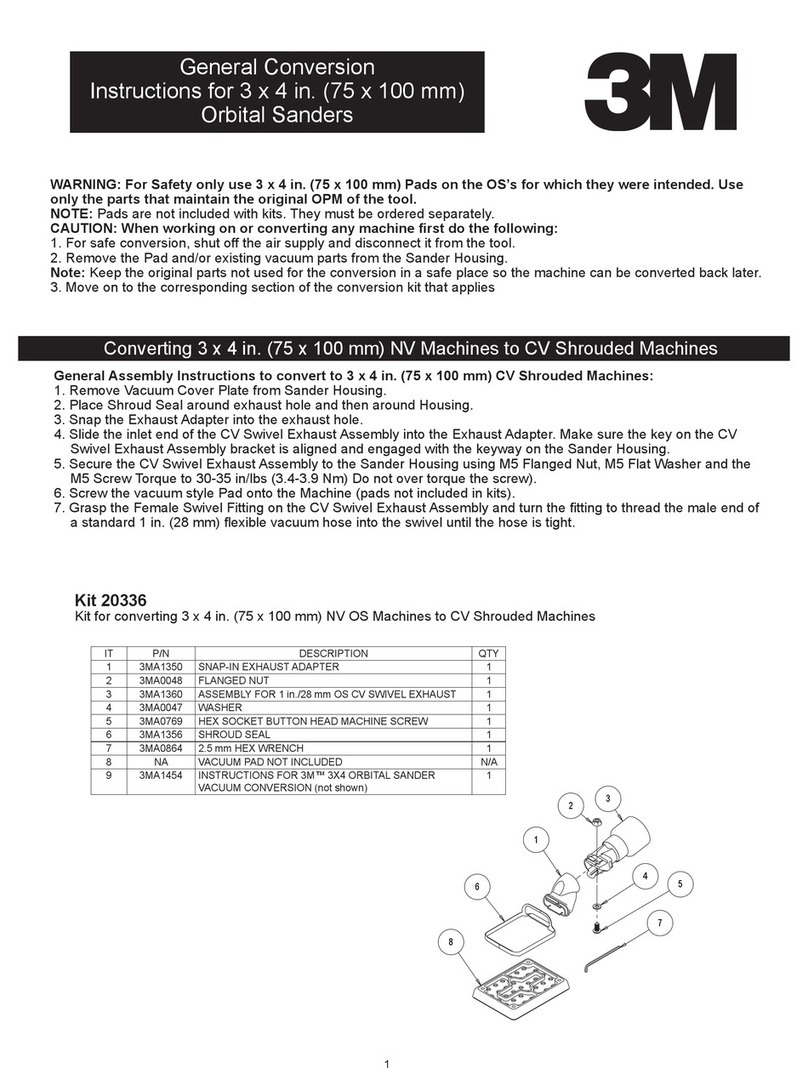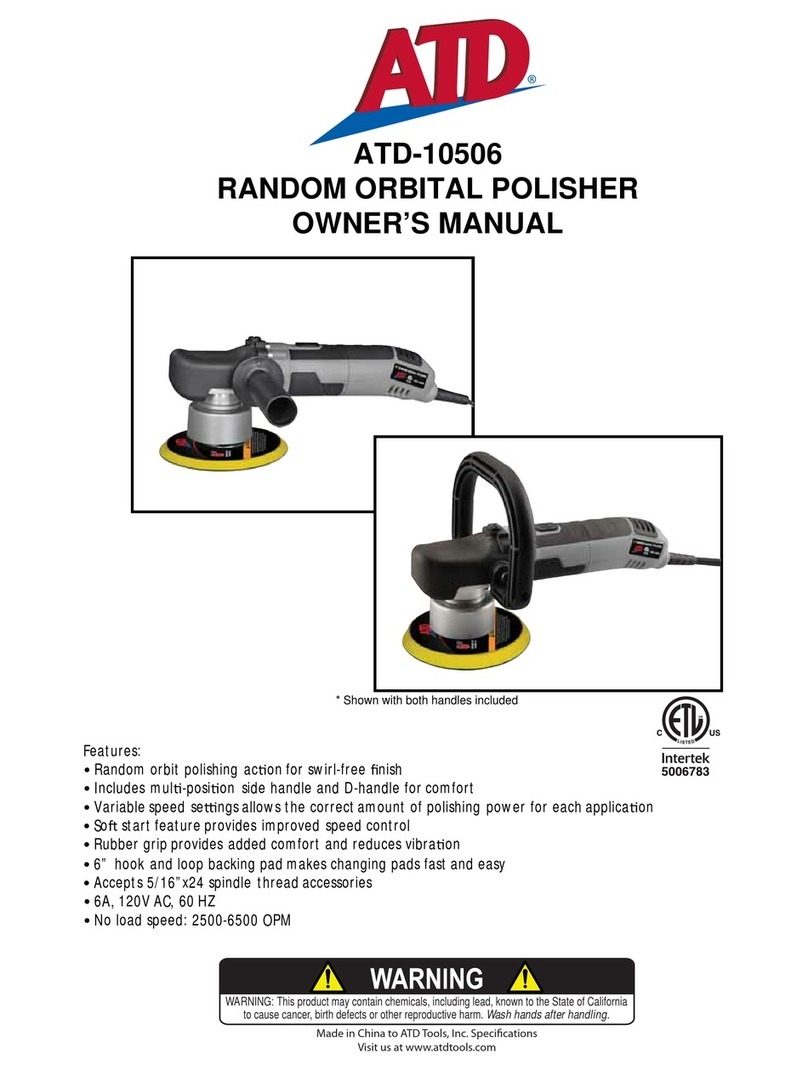Hercules HD035B Assembly instructions

12V Variable Speed Polisher/Sander
Model
HD035B
Battery and Charger Sold Separately
WARNING: To prevent serious injury, User must read and
understand Owner’s Manual. SAVE THIS MANUAL.
When unpacking, make sure that the product is intact and undamaged.
If any parts are missing or broken, please call 1‑888‑866‑5797
as soon as possible. Reference 57735.
Owner’s Manual &
Safety Instructions
23d

Page 2 For technical questions, please call 1-888-866-5797. Item 57735
IMPORTANT SAFETY INFORMATION
GENERAL POWER TOOL SAFETY WARNINGS
Read all safety warnings, instructions, illustrations
and specifications provided with this power tool.
Failure to follow all instructions listed below may result
in electric shock, fire and/or serious injury.
Save all warnings and instructions
for future reference.
The term ″power tool″ in the warnings refers
to your mains-operated (corded) power tool
or battery-operated (cordless) power tool.
Work Area Safety
1. Keep work area clean and well lit.
Cluttered or dark areas invite accidents.
2. Do not operate power tools in explosive
atmospheres, such as in the presence of
flammable liquids, gases or dust. Power tools
create sparks which may ignite the dust or fumes.
3. Keep children and bystanders
away while operating a power tool.
Distractions can cause you to lose control.
Electrical Safety
1. Power tool plugs must match the outlet.
Never modify the plug in any way.
Do not use any adapter plugs with earthed
(grounded) power tools. Unmodified plugs and
matching outlets will reduce risk of electric shock.
2. Avoid body contact with earthed or grounded
surfaces such as pipes, radiators, ranges and
refrigerators. There is an increased risk of electric
shock if your body is earthed or grounded.
3. Do not expose power tools to rain or wet
conditions. Water entering a power tool
will increase the risk of electric shock.
4. Do not abuse the cord. Never use the cord for
carrying, pulling or unplugging the power tool.
Keep cord away from heat, oil, sharp edges
or moving parts. Damaged or entangled
cords increase the risk of electric shock.
5. When operating a power tool outdoors,
use an extension cord suitable for
outdoor use. Use of a cord suitable for outdoor
use reduces the risk of electric shock.
6. If operating a power tool in a damp location
is unavoidable, use a Ground Fault Circuit
Interrupter (GFCI) protected supply.
Use of a GFCI reduces the risk of electric shock.
Personal Safety
1. Stay alert, watch what you are doing and use
common sense when operating a power tool.
Do not use a power tool while you are tired
or under the influence of drugs, alcohol or
medication. A moment of inattention while operating
power tools may result in serious personal injury.
2. Use personal protective equipment. Always wear
eye protection. Protective equipment such
as dust mask, non-skid safety shoes, hard hat,
or hearing protection used for appropriate
conditions will reduce personal injuries.
3. Prevent unintentional starting. Ensure the switch
is in the off-position before connecting to
power source and/or battery pack, picking up
or carrying the tool. Carrying power tools with
your finger on the switch or energizing power
tools that have the switch on invites accidents.
4. Remove any adjusting key or wrench before
turning the power tool on. A wrench or
a key left attached to a rotating part of the
power tool may result in personal injury.
5. Do not overreach. Keep proper footing and
balance at all times. This enables better control
of the power tool in unexpected situations.
6. Dress properly. Do not wear loose clothing or
jewelry. Keep your hair, clothing and gloves
away from moving parts. Loose clothes, jewelry
or long hair can be caught in moving parts.
7. If devices are provided for the connection of
dust extraction and collection facilities, ensure
these are connected and properly used. Use of
dust collection can reduce dust-related hazards.
8. Do not let familiarity gained from frequent use
of tools allow you to become complacent and
ignore tool safety principles. A careless action
can cause severe injury within a fraction of a second.
9. Only use safety equipment that has been approved
by an appropriate standards agency. Unapproved
safety equipment may not provide adequate
protection. Eye protection must be ANSI‑approved
and breathing protection must be NIOSH‑approved
for the specific hazards in the work area.
10. Do not leave the tool unattended when the
Battery Pack is connected. Turn off the tool,
and remove the Battery Pack before leaving.
11. This product is not a toy.
Keep it out of reach of children.
12. People with pacemakers should consult their
physician(s) before use. Electromagnetic fields in
close proximity to heart pacemaker could cause
pacemaker interference or pacemaker failure.

Page 3For technical questions, please call 1-888-866-5797.Item 57735
13. The warnings, precautions, and instructions
discussed in this instruction manual cannot
cover all possible conditions and situations
that may occur. It must be understood by the
operator that common sense and caution are
factors which cannot be built into this product,
but must be supplied by the operator.
Power Tool Use and Care
1. Do not force the power tool. Use the
correct power tool for your application.
The correct power tool will do the job better and
safer at the rate for which it was designed.
2. Do not use the power tool if the switch
does not turn it on and off. Any power tool
that cannot be controlled with the switch
is dangerous and must be repaired.
3. Disconnect the plug from the power source
and/or remove the battery pack, if detachable,
from the power tool before making any
adjustments, changing accessories, or storing
power tools. Such preventive safety measures
reduce the risk of starting the power tool accidentally.
4. Store idle power tools out of the reach of
children and do not allow persons unfamiliar
with the power tool or these instructions
to operate the power tool. Power tools are
dangerous in the hands of untrained users.
5. Maintain power tools and accessories.
Check for misalignment or binding of moving
parts, breakage of parts and any other
condition that may affect the power tool’s
operation. If damaged, have the power tool
repaired before use. Many accidents are
caused by poorly maintained power tools.
6. Keep cutting tools sharp and clean. Properly
maintained cutting tools with sharp cutting edges
are less likely to bind and are easier to control.
7. Use the power tool, accessories and tool bits
etc. in accordance with these instructions,
taking into account the working conditions
and the work to be performed. Use of the
power tool for operations different from those
intended could result in a hazardous situation.
8. Keep handles and grasping surfaces dry, clean
and free from oil and grease. Slippery handles
and grasping surfaces do not allow for safe handling
and control of the tool in unexpected situations.
Battery Tool Use and Care
1. Recharge only with the charger specified by
the manufacturer. A charger that is suitable
for one type of battery pack may create a risk
of fire when used with another battery pack.
2. Use power tools only with specifically
designated battery packs. Use of any other
battery packs may create a risk of injury and fire.
3. When battery pack is not in use, keep it away
from other metal objects, like paper clips,
coins, keys, nails, screws or other small metal
objects, that can make a connection from
one terminal to another. Shorting the battery
terminals together may cause burns or a fire.
4. Under abusive conditions, liquid may be
ejected from the battery; avoid contact.
If contact accidentally occurs, flush with
water. If liquid contacts eyes, additionally
seek medical help. Liquid ejected from the
battery may cause irritation or burns.
5. Prevent unintentional starting. Ensure the
switch is in the off-position before connecting
to battery pack, picking up or carrying the
power tool. Carrying the power tool with your
finger on the switch or energizing power tool
that have the switch on invites accidents.
6. Disconnect the battery pack from the
power tool before making any adjustments,
changing accessories, or storing power tool.
Such preventive safety measures reduce the
risk of starting the power tool accidentally
7. Do not use a battery pack or power tool that
is damaged or modified. Damaged or modified
batteries may exhibit unpredictable behavior
resulting in fire, explosion or risk of injury.
8. Do not expose a battery pack or power tool to
fire or excessive temperature. Exposure to fire or
temperature above 140°F may cause explosion.
9. Follow all charging instructions and do
not charge the battery pack or power tool
outside of the temperature range specified
in the instructions. Charging improperly or at
temperatures outside of the specified range may
damage the battery and increase the risk of fire.
10. Have servicing performed by a qualified
repair person using only identical
replacement parts. This will ensure that
the safety of the product is maintained.
11. Do not modify or attempt to repair the power
tool or the battery pack except as indicated
in the instructions for use and care.
12. The battery Charger gets hot during use.
The Charger’s heat can build up to unsafe
levels and create a fire hazard if it does
not receive adequate ventilation, due to
an electrical fault, or if it is used in a hot environment.
Do not place the Charger on a flammable surface.
Do not obstruct any vents on the Charger.
Especially avoid placing the Charger on carpets
and rugs; they are not only flammable, but they
also obstruct vents under the Charger. Place the
Charger on a stable, solid, nonflammable surface
(such as a stable metal workbench or concrete floor)
at least 1 foot away from all flammable objects, such
as drapes or walls. Keep a fire extinguisher and a
smoke detector in the area. Frequently monitor the
Charger and Battery Pack while charging.

Page 4 For technical questions, please call 1-888-866-5797. Item 57735
Service
1. Have your power tool serviced by a
qualified repair person using only identical
replacement parts. This will ensure that the
safety of the power tool is maintained.
2. Never service damaged BATTERY packs. Service
of BATTERY packs should only be performed by
the manufacturer or authorized service providers.
3. Maintain labels and nameplates on the tool.
These carry important safety information.
If unreadable or missing, contact
Harbor Freight Tools for a replacement.
Lithium Battery Safety Warnings
LITHIUM BATTERIES
STORE A LARGE AMOUNT
OF ENERGY AND WILL
VENT FIRE OR EXPLODE IF MISTREATED:
1. Keep Battery Pack dry.
2. DO NOT DO ANY OF THE FOLLOWING
TO THE BATTERY PACK:
• Open
• Drop
• Short-circuit
• Puncture
• Incinerate
• Expose to temperatures greater than 140°F.
3. Charge Battery Pack only according
to its Charger’s instructions.
4. Inspect Battery Pack before every use;
do not use or charge if damaged.
Safety Warnings Common for
Sanding or Polishing Operations
1. This power tool is intended to function
as a sander or polisher. Read all
safety warnings, instructions, illustrations and
specifications provided with this power tool.
Failure to follow all instructions listed below may
result in electric shock, fire and/or serious injury.
2. Operations such as grinding, wire brushing,
or cutting-off are not recommended to be
performed with this power tool. Operations
for which the power tool was not designed may
create a hazard and cause personal injury.
3. Do not use accessories which are not
specifically designed and recommended
by the tool manufacturer. Just because the
accessory can be attached to your power tool,
it does not assure safe operation.
4. The rated speed of the accessory must be at
least equal to the maximum speed marked on
the power tool. Accessories running faster than
their RATED SPEED can break and fly apart.
5. The outside diameter and the thickness of your
accessory must be within the capacity rating
of your power tool. Incorrectly sized accessories
cannot be adequately guarded or controlled.
6. The arbor size of wheels, flanges, backing
pads or any other accessory must properly
fit the spindle of the power tool. Accessories
with arbor holes that do not match the mounting
hardware of the power tool will run out of balance,
vibrate excessively and may cause loss of control.
7. Do not use a damaged accessory.
Before each use inspect the accessory such
as abrasive wheels for chips and cracks,
backing pad for cracks, tear or excess wear,
wire brush for loose or cracked wires. If power
tool or accessory is dropped, inspect for
damage or install an undamaged accessory.
After inspecting and installing an accessory,
position yourself and bystanders away from
the plane of the rotating accessory and run
the power tool at maximum no-load speed
for one minute. Damaged accessories will
normally break apart during this test time.
8. Wear personal protective equipment. Depending
on application, use face shield, safety goggles
or safety glasses. As appropriate, wear dust
mask, hearing protectors, gloves and workshop
apron capable of stopping small abrasive or
workpiece fragments. The eye protection must
be capable of stopping flying debris generated
by various operations. The eye protection must
be capable of stopping flying debris generated by
various operations. The dust mask or respirator
must be capable of filtering out particles generated
by your operation. Prolonged exposure to high
intensity noise may cause hearing loss.
9. Keep bystanders a safe distance away
from work area. Anyone entering the
work area must wear personal protective
equipment. Fragments of workpiece or of a
broken accessory may fly away and cause
injury beyond immediate area of operation.
10. Hold power tool by insulated gripping surfaces
only, when performing an operation where
the accessory may contact hidden wiring
or its own cord. An accessory contacting a
″live″ wire may make exposed metal parts of
the power tool ″live″ and shock the operator.
11. Never lay the power tool down until the
accessory has come to a complete stop.
The spinning accessory may grab the surface
and pull the power tool out of your control.
12. Do not run the power tool while carrying
it at your side. Accidental contact with the
spinning accessory could snag your clothing,
pulling the accessory into your body.

Page 5For technical questions, please call 1-888-866-5797.Item 57735
13. Regularly clean the power tool’s air vents.
The motor’s fan will draw the dust inside
the housing and excessive accumulation of
powdered metal may cause electrical hazards.
14. Do not operate the power tool near flammable
materials. Sparks could ignite these materials.
15. Do not use accessories that require liquid
coolants. Using water or other liquid coolants
may result in electrocution or shock.
16. Maintain labels and nameplates on the tool.
These carry important safety information.
If unreadable or missing, contact
Harbor Freight Tools for a replacement.
17. Avoid unintentional starting.
Prepare to begin work before turning on the tool.
18. Do not depress the spindle lock when
starting or during operation.
19. Do not leave the tool unattended when the
Battery Pack is connected. Turn off the tool,
and remove the Battery Pack before leaving.
20. Use clamps (not included) or other practical
ways to secure and support the workpiece to
a stable platform. Holding the work by hand
or against your body is unstable and may
lead to loss of control and personal injury.
21. The battery charger gets hot during use.
The charger’s heat can build up to unsafe
levels and create a fire hazard if it does
not receive adequate ventilation, due to an
electrical fault, or if it is used in a hot environment.
Do not place the charger on a flammable surface.
Do not obstruct any vents on the charger.
Especially avoid placing the charger on carpets
and rugs; they are not only flammable, but they
also obstruct vents under the charger.
22. This product is not a toy.
Keep it out of reach of children.
23. People with pacemakers should consult their
physician(s) before use. Electromagnetic fields in
close proximity to heart pacemaker could cause
pacemaker interference or pacemaker failure.
In addition, people with pacemakers should:
• Avoid operating alone.
• Do not use with power switch locked on.
• Properly maintain and inspect
to avoid electrical shock.
• Properly ground power cord. Ground Fault Circuit
Interrupter (GFCI) should also be implemented
– it prevents sustained electrical shock.
24. The warnings, precautions, and instructions
discussed in this instruction manual cannot
cover all possible conditions and situations
that may occur. It must be understood by the
operator that common sense and caution are
factors which cannot be built into this product,
but must be supplied by the operator.
Kickback and Related Warnings
Kickback is a sudden reaction to a pinched or
snagged rotating wheel, backing pad, brush
or any other accessory. Pinching or snagging
causes rapid stalling of the rotating accessory
which in turn causes the uncontrolled power
tool to be forced in the direction opposite of the
accessory’s rotation at the point of the binding.
For example, if an abrasive wheel is snagged or
pinched by the workpiece, the edge of the wheel
that is entering into the pinch point can dig into the
surface of the material causing the wheel to climb
out or kick out. The wheel may either jump toward
or away from the operator, depending on direction
of the wheel’s movement at the point of pinching.
Abrasive wheels may also break under these conditions.
Kickback is the result of power tool misuse and/or
incorrect operating procedures or conditions and can be
avoided by taking proper precautions as given below.
1. Maintain a firm grip on the power tool and
position your body and arm to allow you to
resist kickback forces. Always use auxiliary
handle, if provided, for maximum control over
kickback or torque reaction during start-up.
The operator can control torque reactions or
kickback forces, if proper precautions are taken.
2. Never place your hand near the rotating
accessory. Accessory may kickback over your hand.
3. Do not position your body in the area where
power tool will move if kickback occurs.
Kickback will propel the tool in direction opposite to
the wheel’s movement at the point of snagging.
4. Use special care when working corners, sharp
edges etc. Avoid bouncing and snagging the
accessory. Corners, sharp edges or bouncing
have a tendency to snag the rotating accessory
and cause loss of control or kickback.
5. Do not attach a saw chain woodcarving
blade or toothed saw blade. Such blades
create frequent kickback and loss of control.
Safety Warnings Specific
for Sanding Operations
Do not use excessively oversized sanding disc
paper. Follow manufacturer’s recommendations
when selecting sanding paper. Larger sanding
paper extending beyond the sanding pad
presents a laceration hazard and may cause
snagging, tearing of the disc or kickback.
Safety Warnings Specific for
Polishing Operations
Do not allow any loose portion of the polishing
pad or its attachment strings to spin freely.
Tuck away or trim any loose attachment strings.
Loose and spinning attachment strings can
entangle your fingers or snag on the workpiece.

Page 6 For technical questions, please call 1-888-866-5797. Item 57735
Vibration Safety
This tool vibrates during use. Repeated or long‑term
exposure to vibration may cause temporary or permanent
physical injury, particularly to the hands, arms and
shoulders. To reduce the risk of vibration‑related injury:
1. Anyone using vibrating tools regularly or for an
extended period should first be examined by a
doctor and then have regular medical check‑ups
to ensure medical problems are not being caused
or worsened from use. Pregnant women or
people who have impaired blood circulation to
the hand, past hand injuries, nervous system
disorders, diabetes, or Raynaud’s Disease should
not use this tool. If you feel any medical or
physical symptoms related to vibration (such as
tingling, numbness, and white or blue fingers),
seek medical advice as soon as possible.
2. Do not smoke during use. Nicotine reduces
the blood supply to the hands and fingers,
increasing the risk of vibration‑related injury.
3. Wear suitable gloves to reduce the
vibration effects on the user.
4. Use tools with the lowest vibration when there
is a choice between different processes.
5. Include vibration‑free periods each day of work.
6. Grip tool as lightly as possible (while still keeping
safe control of it). Let the tool do the work.
7. To reduce vibration, maintain the tool as
explained in this manual. If any abnormal
vibration occurs, stop use immediately.
SAVE THESE
INSTRUCTIONS.
GROUNDING
TO PREVENT ELECTRIC SHOCK AND
DEATH FROM INCORRECT GROUNDING:
Check with a qualified electrician if you
are in doubt as to whether the outlet is
properly grounded. Do not modify the power cord
plug provided with the charger. Do not use the
charger if the power cord or plug is damaged.
If damaged, have it repaired by a service facility
before use. If the plug will not fit the outlet,
have a proper outlet installed by a
qualified electrician.
Extension Cords
Note: Extension cords must not be
used with this item’s Charger.
Warning Symbols and Definitions
This is the safety alert symbol. It is used to
alert you to potential personal injury hazards.
Obey all safety messages that follow this symbol to
avoid possible injury or death.
Indicates a hazardous
situation which, if not
avoided, will result in death or serious injury.
Indicates a hazardous
situation which, if not
avoided, could result in death or serious injury.
Indicates a hazardous
situation which, if not
avoided, could result in minor or moderate injury.
Addresses practices not
related to personal injury.

Page 7For technical questions, please call 1-888-866-5797.Item 57735
SYMBOLOGY
VVolts
Direct Current
AAmperes
n0xxxx/min. No Load Revolutions
per Minute (RPM)
WARNING marking concerning Risk
of Eye Injury. Wear ANSI‑approved
safety goggles with side shields.
Read the manual before
set‑up and/or use.
WARNING marking concerning Risk
of Respiratory Injury. Wear NIOSH‑
approved breathing protection rated
for the hazards in your work area.
WARNING marking
concerning Risk of Fire.
Do not cover Charger
ventilation ducts.
Charge on fireproof surface only.
WARNING marking concerning
Risk of Explosion.
Do not puncture, short, or open
battery packs and do not charge
damaged battery packs.
WARNING marking concerning
Risk of Electric Shock.
Properly connect Charger’s power
cord to appropriate outlet.
SPECIFICATIONS
Battery 57367 Hercules 12V Li‑ion
(sold separately)
Charger 56561 Hercules 12V Li‑ion
(sold separately)
No Load Speed n0: 0 – 2800/min, 0‑8300/min
Spindle Thread 5/16"
Max. Accessory
Diameter
Polishing 3" (76mm)
Sanding 2" (51
mm
)
SETUP – BEFORE USE
Read the ENTIRE IMPORTANT
SAFETY INFORMATION section at the
beginning of this manual including
all text under subheadings therein
before set up or use of this product.
Charging
Charge battery pack after unpacking and before using
this tool. Follow instructions included with battery
charger (battery pack and charger sold separately).
Functional Description
2
1
3
4
5
1. Spindle Lock
2. Spindle
3. Trigger
4. Trigger Lock
5. Speed Switch
Assembly
TO PREVENT SERIOUS INJURY:
Do not operate this tool with one hand only or
without the Auxiliary Handle properly installed.
Auxiliary Handle
1. The Auxiliary Handle may be installed
on either side of the Gear Housing.
2. Screw the threaded end of the
Auxiliary Handle into the selected position.
Tighten securely before beginning work.

Page 8 For technical questions, please call 1-888-866-5797. Item 57735
OPERATING INSTRUCTIONS
Read the ENTIRE IMPORTANT
SAFETY INFORMATION section at the
beginning of this manual including
all text under subheadings therein
before set up or use of this product.
Tool Set Up
TO PREVENT SERIOUS INJURY FROM
ACCIDENTAL OPERATION:
Make sure that the Power Switch/Trigger is in the
off-position and remove its Battery Pack before
performing any procedure in this section.
Backing Pad
Push Spindle Lock, then thread Polishing or Sanding
Backing Pad into Output Spindle securely.
Workpiece and Work Area Set Up
1. Designate a work area that is clean and well‑lit.
The work area must not allow access by children
or pets to prevent distraction and injury.
2. If working on panels not attached to a vehicle,
secure loose workpieces using a vise or clamps
(not included) to prevent movement while working.
3. There must not be hazardous objects, such
as utility lines or foreign objects, nearby that
will present a hazard while working.
4. You must use personal safety equipment including,
but not limited to, ANSI‑approved eye and hearing
protection, as well as heavy‑duty work gloves.
Polishing Instructions
TO PREVENT SERIOUS INJURY: Grip the tool firmly.
1. Wash the work surface thoroughly, and
make sure it is free of dust, dirt, oil, grease, etc.
2. Place a clean Wool or Foam Pad (sold separately)
securely onto the Backing Pad. The Pad must
be centered on the Backing Pad to reduce
vibration and allow proper control of the tool.
3. Set Speed Switch to 1.
NOTICE: Only use slower speeds for polishing.
Otherwise, damage may occur to the paint
being polished. Harbor Freight Tools is not
responsible for damage to the vehicle’s
finish due to improper use of this tool.
4. Apply a line 3‑5 inches long of product (compound,
polish or product) on the work surface.
5. Make sure that the Trigger is in the off
position, then connect the battery pack.
CAUTION! Start and stop the tool only while it is
held firmly against the surface of the vehicle. Failure
to do so may result in the Foam Pad or Polishing
Bonnet being thrown from the Polishing Pad.
6. Position the pad to the right of the line of product.
Align the tool so that the line of product aligns to
what would be roughly 10 o’clock on the pad.
WARNING! TO PREVENT SERIOUS
INJURY: Allow the tool to come to a
complete stop before setting it down.
7. Hold the polisher firmly, slightly lift (roughly 10
degrees) the leading edge of the pad and gently
pull the trigger and begin moving the pad from right
to left over the line of product on the surface. This
will pull the product into and under the pad, rather
than shooting it out and splattering it on the panel.
Keep pressure off of the tool when operating. The
Pad should LIGHTLY contact the polishing surface.
8. The entire process of picking up the line of product
should take only a second or two, then immediately
return the pad face to being flat on the work
surface and spread product over a work area no
larger than 2 feet by 2 feet to begin working.
NOTICE: To prevent damage to the Pad
and vehicle finish, only apply the Pad flat
against the surface when polishing.

Page 9For technical questions, please call 1-888-866-5797.Item 57735
Polishing Angle
Note: The most common error when polishing a vehicle
is applying too much product. If the Pad becomes
saturated with product, removing product will be
more difficult and will take longer. Applying too much
product may also reduce the life of the Pad. If the Pad
continually comes off the Backing Pad during use,
too much product may have been applied.
9. Apply the product to all flat surfaces with broad,
sweeping strokes in a crisscross pattern to
ensure complete and even coverage.
10. Repeat previous steps to add more product.
Clean the pad often with compressed
air or a pad cleaning brush or spur.
11. When done, clean the pad, remove the battery
from the tool, then remove the pad and properly
store each indoors and out of children’s reach.
SANDING INSTRUCTIONS
TO PREVENT SERIOUS INJURY: Grip the tool firmly.
1. Make sure that the surface to be sanded is wiped
clean of all dirt and debris, especially that of
previous courser sanding sessions, which will
scratch the surface of a finer grit sanding session.
2. Attach the desired grit Sanding Disk (sold
separately) onto the Backing Pad.
3. Set Speed Switch to 2.
4. Make sure that the Trigger is in the off
position, then connect the Hercules 20V Li‑Ion
battery into the battery compartment.
5. To start, grip the Polisher/Sander firmly and
press the Trigger. Release the Trigger to stop.
To use the Trigger Lock button, while holding in
the Trigger, press the Trigger Lock button, then
release the Trigger. The Polisher/Sander will stay
on. Press and release the Trigger to stop.
6. Wait until the Polisher/Sander has reached
full speed, then gently contact the surface.
7. Keep heavy pressure off of the Polisher/Sander when
operating. Allow the sanding disk to do the work.
8. Move the Polisher/Sander in a uniform
pattern up and down or side to side as
you sand to ensure even sanding.
9. Periodically, stop the Polisher/Sander and
check for possible disc wear. Replace used
or worn sanding discs when necessary.
10. When finished, turn off and remove
battery from the Polisher/Sander.
11. Allow the tool to come to a complete
stop before setting it down.
12. To prevent accidents, turn off the tool and
disconnect its power supply after use. Clean, then
store the tool indoors out of children’s reach.

Page 10 For technical questions, please call 1-888-866-5797. Item 57735
MAINTENANCE AND SERVICING
Procedures not specifically explained
in this manual must be performed
only by a qualified technician.
TO PREVENT SERIOUS INJURY FROM
ACCIDENTAL OPERATION:
Make sure that the Trigger is in the off
position and remove its Battery Pack before
performing any procedure in this section.
TO PREVENT SERIOUS INJURY
FROM TOOL FAILURE:
Do not use damaged equipment.
If abnormal noise or vibration occurs, have
the problem corrected before further use.
Cleaning, Maintenance,
and Lubrication
1. BEFORE EACH USE, inspect the general
condition of the tool. Check for:
• leaking, swollen, or cracked battery pack,
• loose hardware,
• misalignment or binding of moving parts,
• cracked or broken parts, and
• any other condition that may
affect its safe operation.
2. AFTER USE, wipe external surfaces
of the tool with clean cloth.
3. Li‑Ion BATTERY MUST BE RECYCLED OR
DISPOSED OF PROPERLY.
Do not short, incinerate or open battery.
4. Periodically, wear ANSI‑approved safety goggles
and NIOSH‑approved breathing protection
and blow dust and grit out of the motor
vents using dry compressed air.
5. Disconnect battery pack and store battery pack,
charger, and tool in dry, indoor area out of
reach of children and away from metal objects
(i.e., paperclips, coins) to prevent shorting.

Page 11For technical questions, please call 1-888-866-5797.Item 57735
Troubleshooting
Problem Possible Causes Likely Solutions
Tool will not start. 1. Battery Pack not properly connected.
2. Battery Pack not properly charged.
3. Battery Pack burnt‑out.
4. Internal damage or wear. (Carbon
brushes or switch, for example.)
1. Remove Battery Pack, make sure there
are no obstructions, reinsert the Battery
Pack according to its shape (it should
only fit one way), and press firmly until
the Battery Pack locks in place.
2. Make sure Charger is connected and
operating properly. Give enough time
for Battery Pack to recharge properly.
3. Dispose of old Battery Pack
properly or recycle. Replace Battery Pack.
4. Have technician service tool.
Tool operates slowly. 1. Excess pressure applied to workpiece.
2. Battery Pack power low.
3. Battery Pack burnt‑out.
1. Decrease pressure, allow
tool to do the work.
2. Recharge Battery Pack.
3. Dispose of old Battery Pack
properly or recycle. Replace Battery Pack.
Performance
decreases over time.
1. Carbon brushes worn or damaged.
2. Battery Pack wearing out.
1. Have qualified technician replace brushes.
2. Battery Pack capacity will gradually
decrease through use. If symptoms
are severe, recycle old Battery Pack
(or dispose of properly) and replace it.
Excessive noise
or rattling.
Internal damage or wear.
(Carbon brushes or bearings, for example.)
Have technician service tool.
Overheating. 1. Forcing tool to work too fast.
2. Blocked motor housing vents.
1. Allow tool to work at its own rate.
2. Wear ANSI‑approved safety goggles
and NIOSH‑approved dust mask/
respirator while blowing dust out of
motor using compressed air.
Tool does not
sand effectively.
1. Disc accessory may be
loose on Spindle.
2. Disc accessory may be damaged, worn
or wrong type for the material.
3. Product sprays off polishing pad.
1. Be sure disc accessory arbor is correct
and Outer Flange/Arbor Nut is tight.
2. Check condition and type of disc accessory.
Use only proper type of disc
accessory in good condition.
3. Reduce RPM to minimum setting.
Follow all safety precautions whenever diagnosing or servicing
the tool. Disconnect power supply before service.
Record Product’s Serial Number Here:
Note: If product has no serial number, record month and year of purchase instead.
Note: Replacement parts may be available for this item.
Visit harborfreight.com/parts for a list of in stock parts. Reference UPC 193175508980.

26677 Agoura Road • Calabasas, CA 91302 • 1-888-866-5797
Visit our website at: http://www.harborfreight.com
For technical questions, please call 1-888-866-5797
Copyright©2023 by Harbor Freight Tools®. All rights reserved. No portion of this manual or
any artwork contained herein may be reproduced in any shape or form without the express
written consent of Harbor Freight Tools. Diagrams within this manual may not be drawn
proportionally. Due to continuing improvements, actual product may differ slightly from the
product described herein. Tools required for assembly and service may not be included.
LIMITED 90 DAY WARRANTY
Harbor Freight Tools Co. makes every effort to assure that its products meet high quality and durability
standards, and warrants to the original purchaser that this product is free from defects in materials
and workmanship for the period of 90 days from the date of purchase. This warranty does not apply to
damage due directly or indirectly, to misuse, abuse, negligence or accidents, repairs or alterations outside
our facilities, criminal activity, improper installation, normal wear and tear, or to lack of maintenance.
We shall in no event be liable for death, injuries to persons or property, or for incidental, contingent,
special or consequential damages arising from the use of our product. Some states do not allow the
exclusion or limitation of incidental or consequential damages, so the above limitation of exclusion
may not apply to you. THIS WARRANTY IS EXPRESSLY IN LIEU OF ALL OTHER WARRANTIES,
EXPRESS OR IMPLIED, INCLUDING THE WARRANTIES OF MERCHANTABILITY AND FITNESS.
To take advantage of this warranty, the product or part must be returned to us with transportation charges
prepaid. Proof of purchase date and an explanation of the complaint must accompany the merchandise.
If our inspection verifies the defect, we will either repair or replace the product at our election or we may
elect to refund the purchase price if we cannot readily and quickly provide you with a replacement. We will
return repaired products at our expense, but if we determine there is no defect, or that the defect resulted
from causes not within the scope of our warranty, then you must bear the cost of returning the product.
This warranty gives you specific legal rights and you may also have other rights which vary from state to state.
Other manuals for HD035B
1
Table of contents
Other Hercules Sander manuals

